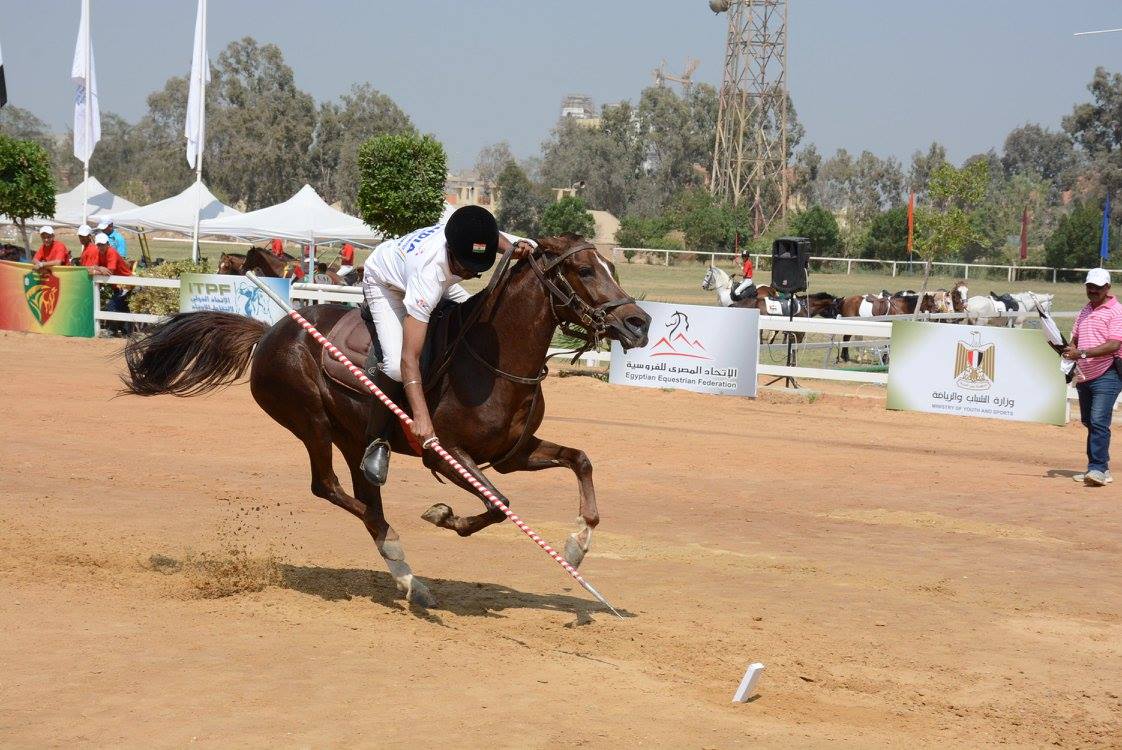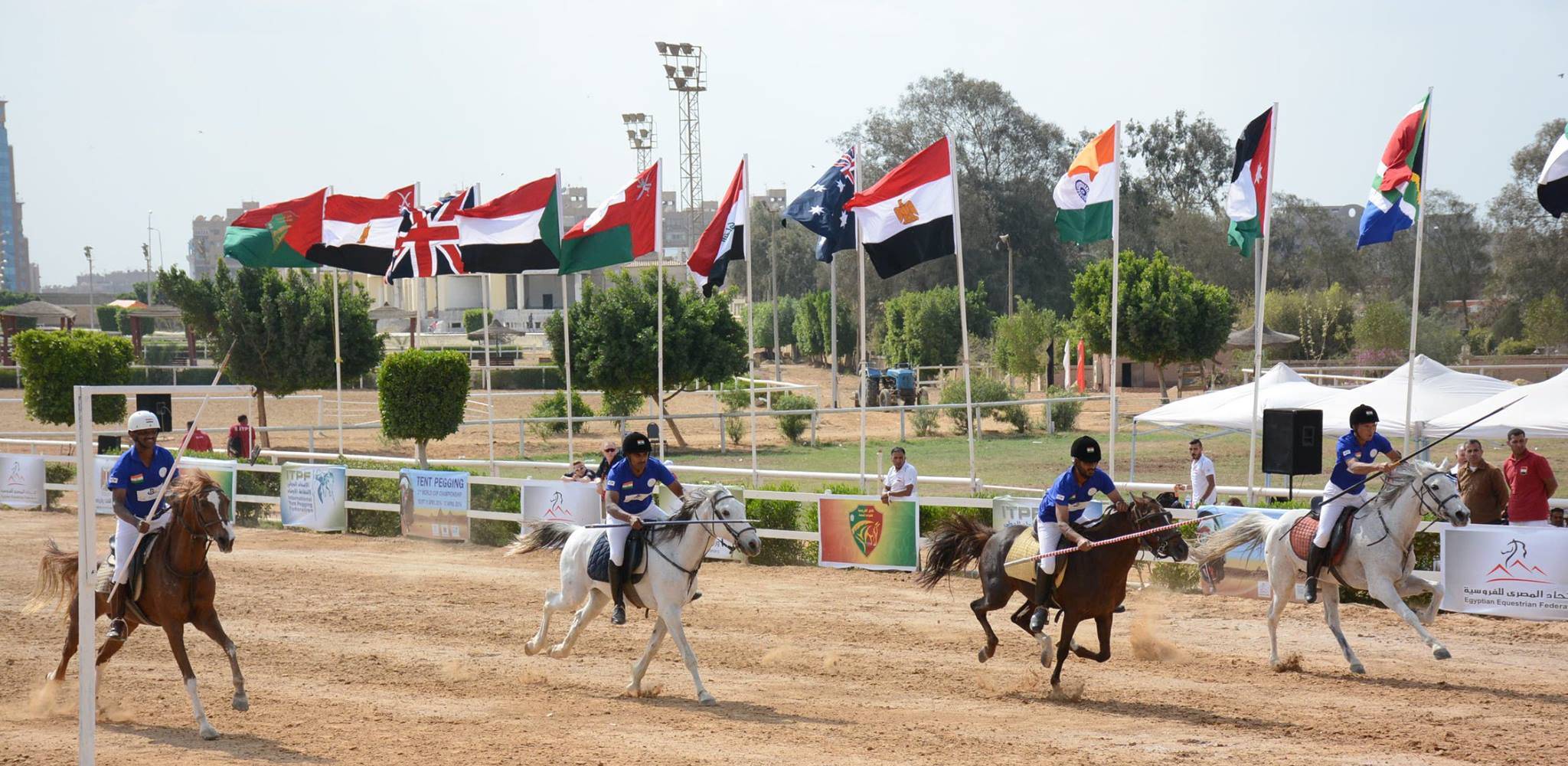History of Tent Pegging
This fast and dramatic sport, in which riders carrying a lance or sword must spear and pick up a peg from the ground while at full gallop, can truly be said to belong to Asia. Cavalrymen have practised the game since at the least the 4th Century BC, and Asian empires were responsible for introducing the sport to other parts of the world. By all accounts the sport developed as a cavalry training exercise designed to develop a soldier’s prowess with sword and lance from the back of his horse, but what is less certain is whether it was used as a general training method or for a specific combat situation. The tests rarely involved jumping obstacles, though participants may well have had to negotiate ditches and rivers on their long rides. It is recorded that in 1680 the Swedish cavalry was training its recruits to jump cross-country fences, and the riding instructor for the cavalry of King Charles XI of Sweden prescribed the following advice: “When jumping a fence the rider will grab the mane, close his eyes and shout ‘hey’”.
One theory is that the sport evolved from a battlefield ploy used in the Middle Ages by horsed cavalry against troops mounted on elephants. The soldiers discovered that the best way to render the elephants ineffective was to attack them with sharp spears aimed behind the toenails of the elephants’ forelegs. This part of the elephant was thought to be the weakest and most sensitive spot on a body that was largely immune to the spear or arrow. The tactics were to send in three or four lancers, riding in single file, to charge at the elephant with lances down, in an attempt to pierce the animal’s flesh just behind his toe nails. The last in line left his lance in the wound. If the charge was successful, the pain caused the elephant to remain rooted the spot or, better still, rear up and unseat his mahout and perhaps run amok, breaking ranks and trampling infantry. It was a dangerous and daring exploit for the attackers, and to boost moral the lancers would yell war cries and twirl their lances with great panache as they approached their target. In earlier days of Tent Pegging competitions such displays of exuberance were expected in order to gain maximum points.
One other theory has it that the sport originated from the practice in North India of conducting dawn raids on sleeping enemy encampments by galloping through the tented lines and lancing and removing the pegs which held the tents in place, thus collapsing the tents on their occupants and causing havoc and terror in the camp.

This seems a less convincing theory if only because there were probably better ways of inflicting damage on an enemy in a surprise attack.In India the sport was taken up with enthusiasm by the British army during the colonial period, and during the first half of the 20th Century it was one of the most popular sporting activities of cavalrymen in India. Sometimes referred to as “Skill-at-Arms”, the broader sport includes ring jousting (in which a galloping rider tries to pass the point of his weapon through a suspended ring), lemon sticking (in which the rider, again at a gallop, attempts to slice a lemon suspended from a rope), and quintain tilting, when a rider must spear a dummy through the heart.

After Independence and the establishment of a unified India, there was little need for the old cavalry regiments which were gradually disbanded until, ultimately, only the 61st Cavalry, an amalgamation of five regiments, remained. The demise of India’s Cavalry also saw the demise of the sport of Tent Pegging, its traditions being kept alive only by a small number of army and police units. In other parts of the world the sport saw a similar decline, yet it still retained enough followers and enthusiasts to keep it going, albeit on a much smaller scale. The catalyst for the sport’s resurgence in the early 80s was its inclusion in the Asian Games in Delhi in 1982 – the result of intense and determined negotiation by the Equestrian Federation of India (EFI) at that time. Having already persuaded the sports minister to include equestrian events in the Asian Games, Gen O P Malhotra, President of the EFI, then had to convince the International Equestrian Federation (FEI), the world’s governing body for equestrian sport, that India should host a Tent Pegging competition at the Games instead of dressage.
The FEI was initially reluctant to support this idea because, in order for Tent Pegging to be included in the Asian Games, it would have to become an official FEI sport. However, after a successful demonstration of Tent Pegging to HRH Prince Phillip, President of the FEI at that time, who visited Delhi in 1981, India’s “new” sport was presented to the FEI delegates and its inclusion eventually got the go ahead.
PRESENT FORM OF THE DISCIPLINE
Tent pegging involves horse and rider racing along a 100 meter course and collecting, cutting, shooting, or accurately "stabbing" a series of pegs, lemons, rings, or mannequins along the way. The targets used for tent pegging has several variations, like, a ring - a rider's weapon should successfully pass through the ring without making contact, a lemon - where, a rider is required to stab or slice a suspended lemon, a mannequin - where a rider should attack at a certain fixed part of the target. Tent pegging competitions vary based on a few factors like, the size and shape of targets, number of consecutive targets, types of weapons allowed, the duration in which the course has to be completed, and the manner in which the target has to be attacked.

Once a rider commences an event, the emphasis is on the object and not on his horses. Tent Pegging calls for a well-schooled horse that will respond to commands instantaneously and have no fear of noise or sudden movements.
If a competitor makes certain faults, such as losing his Lance, Sword or exceeding the time allowed etc. he incurs penalties. Those penalty points will be deducted from the points he gains. The winner of the competition is the competitor who gains the highest number of points.
A high standard of riding skill is required to gallop a horse at full speed and maintain posture as judges award points for the style and accuracy with which objects are struck or retrieved.
If a competitor makes certain faults, such as losing his Lance, Sword or exceeding the time allowed etc. he incurs penalties. Those penalty points will be deducted from the points he gains. The winner of the competition is the competitor who gains the highest number of points.
A high standard of riding skill is required to gallop a horse at full speed and maintain posture as judges award points for the style and accuracy with which objects are struck or retrieved.
AWARD OF POINTS-PEGS
6 Points :- For wooden pegs carried all the way or falls forward / sideways beyond 15 meters. For cardboard pegs carried all the way or falls forward / sideways beyond 10m measured from the point at which the peg was placed. In single file same principle holds good. Peg struck with point of lance or sword but breaks and part of it still in the ground , even if no part of it still attached to the weapon.
4 Points :- Peg removed from the ground, but not carried full distance as stipulated above.
2 Points :- Peg struck on face, but not removed from its position in the ground.
4 Points :- Peg removed from the ground, but not carried full distance as stipulated above.
2 Points :- Peg struck on face, but not removed from its position in the ground.
Note:- Peg must be struck on the face of the peg by the point of the weapon and must leave a mark on the peg (marks on the side of the pegs are not countable). Doubtful pegs must be handed over to the jury.
| Rings | Peg |
|---|---|
| Rings carried on lance | 6 each |
| Carry Peg | 6 |
| Draw of peg | 4 |
| Strike of peg | 2 |
Horizontal Slice or Cut on Lemon – Must be clear and distinct and caused due to use of
| Lemon | Peg |
|---|---|
| Sword | 6 each |
| Carry Peg | 6 |
| Draw of peg | 4 |
| Strike of peg | 2 |

